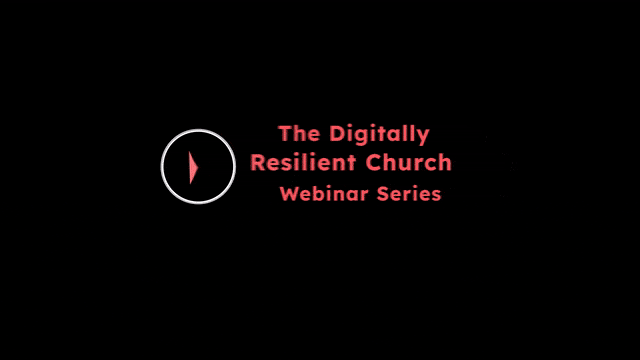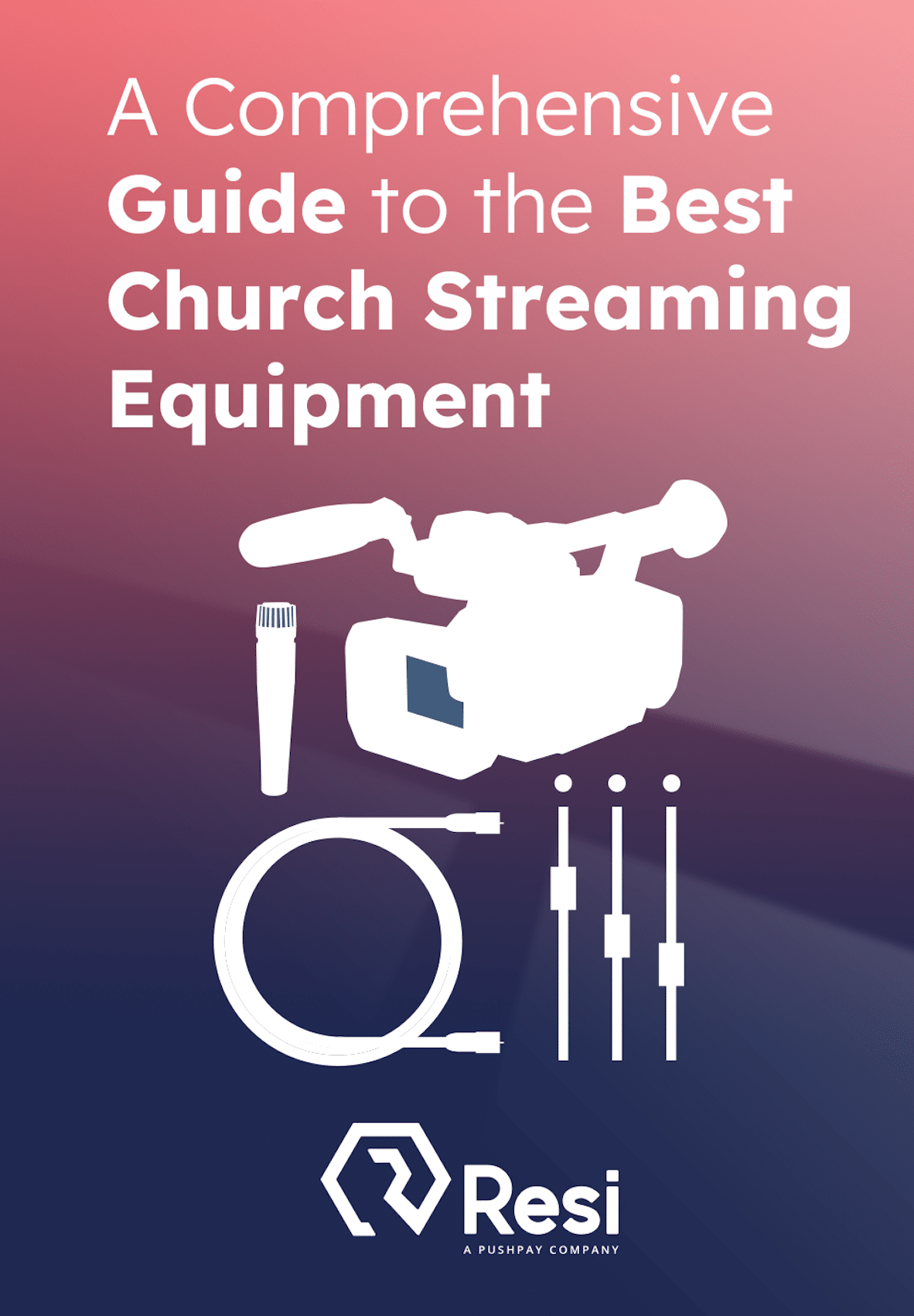
Now more than ever, church livestreaming has become a crucial part of modern church services. It’s not just about reaching people who can’t physically be there, it’s about making sure everyone feels included, connected, and part of the worship experience. Let’s dive into this church livestreaming checklist to make sure you’re set up for success.
Your Church Streaming Checklist
Getting a livestream set up isn’t as simple as hitting a button on your phone. It needs careful planning, the right equipment, and a whole lot of dedication, but completing the items on this church livestreaming checklist is a great place to start.
And when you’ve got a well-prepared livestreaming setup, it’s a game-changer! It takes the worship experience to a whole new level for online attendees, letting them join and connect with the service from anywhere.
✅ Pre-Service Preparation
Before we dive into the heart of our service, there’s a critical stage we cannot overlook – pre-service preparation. It’s like the warm-up before a big game. It sets the tone for everything that follows.
Technical Equipment Check
Everyone has their own processes for a pre-service check, but we would recommend that you check each of the following before every livestream service:
1. Cameras: Cameras are our eyes, capturing every moment of our service. So, let’s make sure those lenses are clean, the settings are right, and the angles are perfect.
2. Microphones: Next up, microphones. They’re our voice, carrying the word of God to our online congregants. Let’s ensure they’re clear, without any static or feedback.
3. Lighting: Then there’s lighting. It’s what illuminates our service, setting the mood and highlighting the important stuff. Check that it’s neither too bright nor too dim, and that it’s focused on the right spots.
4. Streaming Hardware or Software: Finally, our streaming hardware and software. They’re the heart of our livestream. Make sure your streaming software is updated and configured correctly, and that your hardware is running smoothly.
Best Livestreaming Equipment
Discover what top-rated equipment we recommend adding to your church streaming toolkit.
Download for free!
Internet Connectivity Test
Now that our equipment is ready, let’s move onto the internet connectivity test. After all, we could have the best equipment in the world, but without a stable internet connection, our livestream is going nowhere.
So, how do we do this? Start by running a speed test. You’re looking for a consistent upload speed of at least 5 Mbps for a high-definition stream. But the higher, the better!
Next, check your network stability. Are you getting a steady signal? Any fluctuations could lead to buffering or interruptions during your livestream.
Lastly, is your network secure? The last thing we need is a security breach during our service. Make sure your network is protected with a strong password and up-to-date security settings.
Preparation is key. By taking these steps, you’re setting the stage for a successful church service livestream.
✅ Setting Up Your Streaming Area
Now that we’ve got our equipment checked and our internet connection stable, let’s turn our attention to setting up the streaming area.
Sound System Configuration
Start by testing all your audio equipment. We’re talking microphones, speakers, mixers – the whole lot. Make sure they’re all working perfectly and delivering clear sound.
Then, check your sound levels. Too low, and your attendees will struggle to hear. Too high, and you’ll get distortion. Again, it’s about hitting that sweet spot.
And don’t forget about acoustics. Are your microphones picking up any unwanted background noise? Is the sound echoing around the room? If so, consider using some sound-absorbing materials on the walls to improve your audio quality.
✅ Stream Testing and Troubleshooting
There’s one last step on our church streaming checklist to do before we go live; stream testing and troubleshooting.
Conducting a Test Stream
Now, you might be thinking, “I’ve followed all the steps. Everything’s working perfectly. Why do I need to run a test stream?” Simply put, it’s like a dress rehearsal before the big show. It’s our chance to iron out any kinks and make sure everything runs smoothly when it’s showtime.
So, how do we do it? Start by running a test stream. To run a test stream with Resi, follow this process:
- Go to the Schedule tab in Resi Studio and click ‘Add Event.’
- Fill in the event details, ensuring you schedule the test stream for at least 5 minutes from now.
- Under Content Source, select ‘Live Encoder,’ and then choose your Encoder from the dropdown menu and then select your Encoder Channel.
- For the purpose of this test, set the destination to ‘Destination Type Web.’
- Save your event and proceed to the next step.
Once your event is scheduled, your encoder should automatically start streaming at the specified time. You can now view your stream via the Media tab and then selecting Web Videos or Encoder Videos.
This way, you can review the recording and check for any issues with your audio and video quality.
Listen to the audio. Is it clear? Can you hear everything clearly? If not, it’s time to tweak those sound settings.
Next, look at the video. Is it sharp and clear? Are the colors accurate? If something’s off, adjust your camera settings or lighting setup.
Troubleshooting Common Issues
Even with all the preparation in the world, issues can pop up. It’s just part of the game. But don’t worry, we’ve got your back! Let’s take a look at some common streaming issues and how to resolve them.
One common issue is buffering or lagging during the stream. This could be due to an unstable internet connection. A couple of common solutions are to reset your router or contact your internet service provider. However, with Resi’s patented Resilient Streaming Protocol (RSP) you can stream with confidence knowing that your livestream won’t buffer or be interrupted due to an unstable internet connection. Additionally, through Resi’s adaptive streaming platform, your livestream will automatically convert to the highest quality allowed by your viewers’ internet speed—meaning that from transmitting to receiving, Resi provides a solution to the most anxiety-inducing aspect of livestreaming your church service.
Another issue could be poor audio or video quality. This might be due to incorrect settings on your equipment. Go back and double-check all your settings. Make sure everything’s configured correctly.
Troubleshooting is all about identifying the problem and finding a solution. And don’t be disheartened if you encounter issues – it’s all part of the process.
✅ During the Service
We’ve checked our equipment, set up our streaming area, and tested our stream. Now, it’s showtime!
Managing the Stream
First up, managing the stream.
Start by monitoring the stream closely. Keep an eye on your streaming software and watch for any glitches or interruptions. If something looks off, don’t panic. Use your troubleshooting skills to identify the problem and fix it quickly.
During your church livestream you’ll want to keep an eye on your audio and video quality. Is the picture still sharp? Is the sound still clear? If not, it might be time to adjust your camera settings or tweak your sound levels.
Engaging with Online Attendees
Now, let’s talk about our online attendees. They’re not just watching the service, they’re a part of it.
Start by encouraging interaction. Use the chat feature on various social media platforms to engage with your attendees. Ask them questions, respond to their comments, and make them feel heard.
Next, consider incorporating elements that specifically cater to your online audience. This could be exclusive online segments, shout-outs to your online attendees, or even an online prayer request segment.
It’s not just about the service itself. It’s about creating a community. Encourage your online attendees to connect with each other, share their experiences, and support one another.
✅ Post-Service Follow-Up
And that’s a wrap, folks! You’ve done it – your service has been successfully livestreamed. But our job isn’t quite done yet.
After the service, it’s important to reach out to your online attendees. Thank them for joining, ask for their feedback, and encourage them to join again next time. Remember, we’re not just streaming a service; we’re building an online community.
Analyzing Stream Performance
Next up, let’s take a look at how our stream performed. This isn’t about patting ourselves on the back (although you definitely deserve it!). It’s about understanding what worked and what didn’t, so we can make our next stream even better.
Start by reviewing your stream. Watch it back and look for any issues with audio or video quality. Did everything run smoothly? Were there any glitches or interruptions?
Then, check your streaming platform’s analytics. How many people tuned in? When did they join, and when did they leave? These stats can give us valuable insights into our audience’s behavior.
How to Review the Stream’s Performance and Gather Feedback from Online Attendees
Now, let’s delve a bit deeper into reviewing the stream’s performance and gathering feedback from our online attendees.
Firstly, don’t be afraid to ask your attendees for their feedback. They’re the ones who experienced the service, so their input is invaluable. Ask them about their experience – was the audio clear? Was the video sharp? Did they feel included in the service?
You can gather this feedback through surveys, comment sections, or direct messages. Feedback isn’t about criticism; it’s about growth.
Making Improvements for Future Church Streams
Alright, we’ve got our feedback, we’ve analyzed our stream performance, now what? Well, it’s time to use those insights to make improvements for our future church live streams.
Every bit of feedback, every statistic, is a chance to learn and grow. Did some attendees struggle to hear the sermon? Let’s improve our audio setup. Did the video lag during the choir performance? Let’s work on our internet connection.
Improvement isn’t a one-time thing. It’s a continual process. With every stream, we’ll learn something new, face a different challenge. But that’s what makes this job so exciting, isn’t it?
Post-service follow-up and continual improvement are key to delivering an unforgettable worship experience for our online attendees. So let’s take that feedback, make those improvements, and get ready for our next service.
Church Streaming Checklist Summary
We’ve covered a lot of ground, so let’s take a moment to recap our church live streaming checklist:
- ✅ Setting Up: We start by setting up our streaming area and ensuring we have the right gear. Remember, good quality audio and video are key.
- ✅ Stream Testing and Troubleshooting: Next up, we run a test stream to check our audio and video quality. If any issues crop up, we troubleshoot and resolve them.
- ✅ During the Service: We then manage the livestream during the service, monitoring for any glitches, and engaging with our online attendees to make them feel included.
- ✅ Post-Service Follow-Up: After the service, we analyze the stream’s performance, gather feedback from online attendees, and make improvements for future streams.
That’s your roadmap to a successful church service livestream. And keep in mind, this isn’t just a one-time checklist. It’s a continuous cycle of preparation, testing, managing, and improving.
Because when we strive for improvement, when we refuse to settle for ‘good enough’, that’s when we create an unforgettable worship experience for our online attendees.







